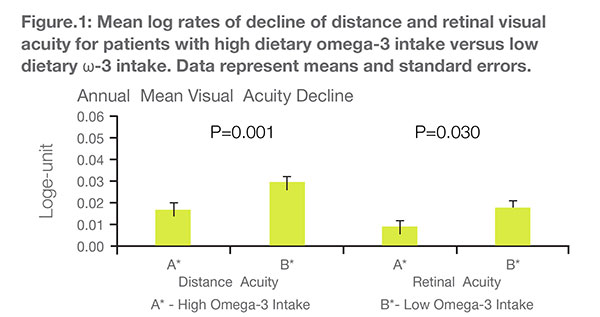A study was conducted to assess whether a diet high in long chain omega-3 fatty acids can slow the rate of loss of visual acuity among patients with retinitis pigmentosa receiving vitamin A palmitate.
357 adult patients who were all receiving vitamin A 15,000 IU/day
Vitamin A 15,000 IU/day for 4-6 years and intake of long chain Omega-3 fatty acids (primarily DHA).
4-6 years
Mean rates of decline of acuity were slower among those with high omega-3 intake; Early Treatment Diabetic Retinopathy Study (ETDRS) distance acuity: high=0.59 letter/year, low=1.00 letter/year, p=0.001 (see Fig.1).
The mean annual rates of change of distance and retinal acuity were slower among those with high omega-3 intake (≥ 0.20 g/day) than among those with low intake (<0.20 g/day).

The mean annual rates of decline in distance and retinal visual acuities in adults with retinitis pigmentosa taking vitamin A are slower among those consuming a diet rich in omega-3 fatty acids (primarily DHA).
Berson EL, Rosner B, Sandberg MA, et al. ω-3 intake and visual acuity in patients with retinitis pigmentosa receiving vitamin A. Arch Ophthalmol. 2012; 130(6):707-11